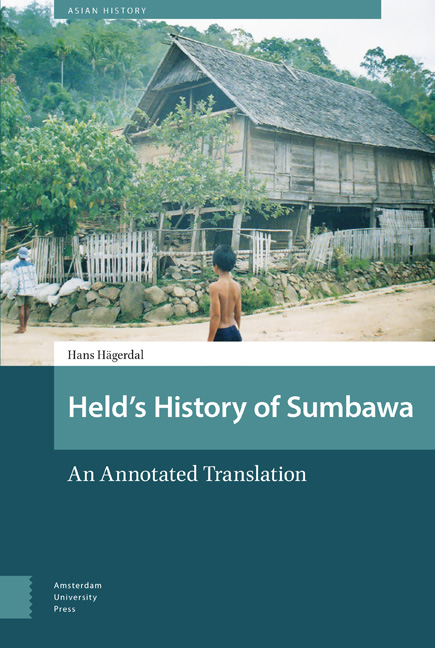Book contents
- Frontmatter
- Contents
- List of Figures and Tables
- Map
- Translator’s Introduction
- 1 The Ancient Period
- 2 Islam and Makassar
- 3 The Sumbawan Kingdoms under VOC Suzerainty (1)
- 4 The Sumbawan Kingdoms under VOC Suzerainty (2)
- 5 In the Wake of the Tambora Disaster
- 6 From Colonial rule to Independence
- Appendix: Lists of Sumbawan Rulers
- Bibliograph
- Index
3 - The Sumbawan Kingdoms under VOC Suzerainty (1)
Published online by Cambridge University Press: 10 December 2020
- Frontmatter
- Contents
- List of Figures and Tables
- Map
- Translator’s Introduction
- 1 The Ancient Period
- 2 Islam and Makassar
- 3 The Sumbawan Kingdoms under VOC Suzerainty (1)
- 4 The Sumbawan Kingdoms under VOC Suzerainty (2)
- 5 In the Wake of the Tambora Disaster
- 6 From Colonial rule to Independence
- Appendix: Lists of Sumbawan Rulers
- Bibliograph
- Index
Summary
[The contract of 1669]
It speaks for itself that Speelman did not consider the matter concluded by this. In 1668 there were envoys from Sumbawa in Makassar in order to negotiate a treaty, but as new conflicts arose between the Makassarese and the Dutch, they withdrew to their land without having concluded a contract (Daghregister, 1668-1669, p. 445). Only when the Makassarese had to bow before the Company for good in mid-1669 did the envoys appeared again to conclude the first contract on 1 October 1669, whereby they again gave up the contact with Makassar and gave the Company a monopoly on trade. The King of Bima was represented by Jeneli Monta and another jeneli (Zenelijwdo?), Dompu by Tureli Huu; furthermore there was another person from the sara mbojo (royal council) whose function is not indicated. The envoys explained that their princes would have liked to come but that they had important reasons to excuse themselves. The princes did of course not give as reason their fear of the ‘just punishment’ that had been promised them in article 15 of the Bungaya treaty, but insisted that ‘we [the kings] are the only ones in the lands of Biema and Dompo who take care of the people … If we came over to you in Makassar the whole population would be scattered, since they are only forest and thuij people, unmannered, stupid and without understanding, who do not grasp the reason’ (Corpus, II, p. 421, [paragraph] 1).
However, they did not get away from Speelman that easily, for he added to the contract that in any case the Prince of Dompu ‘with the foremost ones’ would now have to appear before the general and the council in Batavia, while the Sultan of Bima, if he absolutely could not come, in any case had to send Tureli Nggampo, who had not been able to come to Makassar. He was sick and ‘lay [in bed in] very bad shape’ (Corpus, II, p. 425, 426, [paragraph] 16).
[The first embassy in 1671]
After a long delay the first embassy appeared in Batavia in December 1671, but again the princes did not accompany it. It consisted of Jeneli Kilo for Dompu and the syahbandar for Bima.
- Type
- Chapter
- Information
- Held's History of SumbawaAn Annotated Translation, pp. 77 - 114Publisher: Amsterdam University PressPrint publication year: 2017



